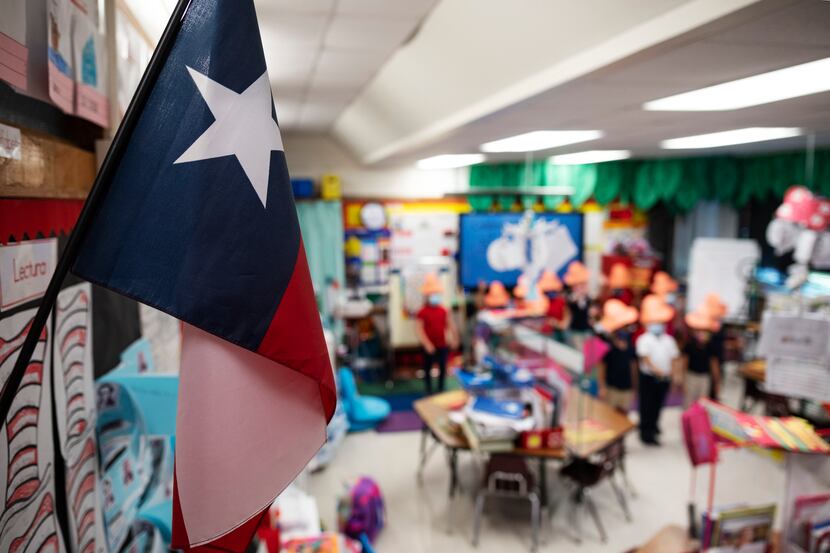Nearly four out of every 10 Texas public school students failed state math exams after the last two years of school were disrupted by the pandemic.
New testing data show more students failed both reading and math tests in 2021 than in 2019, the last year state exams were administered. State officials suggested that learning loss was most dramatic in school districts with more students learning virtually for the majority of the school year.
This trend was true for students of all races and for both students who qualify as economically disadvantaged and those who do not, according to TEA data, but more pronounced for Black and Hispanic students.
The Texas Education Agency released results from the State of Texas Assessments of Academic Readiness exams Monday, providing the clearest picture of how much students fell behind since the pandemic began. Until now, the scope of learning loss had been unknown and educators could only speculate about the challenges to come in catching their students up.
“This is probably 800,000 more students in Texas in mathematics that are noticeably below grade level this year as a result of COVID than in normal years,” Education Commissioner Mike Morath said. “It is important to remember that these are not numbers, these are children.”
The test results show more students not meeting grade level benchmarks in almost all subject areas and nearly every grade with the steepest learning loss in math. This year, 37% of students tested failed math exams and 33% failed reading tests -- an uptick of 16% and 4% respectively over 2019 results.
In the Dallas/Fort Worth area, some of the indicators of learning losses were alarming.
Dallas ISD, the area’s largest district, saw declines across the board in math and reading scores for its elementary and middle school students, with at least a third of those students failing to meet state standards from 3rd to 8th grade.
One stark example was in 7th grade math, where 71% of DISD students failed the test. In Fort Worth ISD, the percentage of seventh-graders who did not meet standard was even higher, at 82%.
Deputy superintendent Susana Cordova said that the numbers confirmed what district administrators saw in DISD’s internal data.
“It’s really an unfortunate interruption of what had been several years of increases in student performance here in Dallas,” Cordova said.
Early national and local data hinted that students would sustain the greatest learning loss in math. Educators suggested the subject was more challenging to learn virtually.
The number of students “mastering” state standards also dipped. Mastering standards means a student is expected to succeed in the next grade level or course with little or no academic intervention. In math, the percentage fell from 26% to 17% and in reading it fell from 21% to 18%.
The only subjects seemingly immune to COVID-19 learning loss were English I and English II, where more students met grade level on the exams than did in 2019.
Virtual learning’s role
Whether a student learned remotely or in-person may have played a role in how they performed on exams. While the state required all districts to offer an in-person option this school year, some -- including Dallas ISD -- delayed returning to campus for several weeks. Others had large numbers of students electing to learn from home even when an on campus option was available.
“Where there was very significant rates of remote instruction, we saw the most significant declines in student proficiency,” Morath said.
Districts with less than a quarter of students learning in person for most of the year sustained greater learning loss, TEA officials said. In these schools, the percentage of students failing math exams increased by 32% and the percentage failing reading tests increased by 9%.
David DeMatthews, an associate professor of educational leadership and policy at the University of Texas, noted that students already learning on campus may have been more comfortable with an in-person testing environment.
Having a strong relationship -- which can be easier to form when interacting face-to-face -- is also essential to learning, he added.
“It’s not a surprise to anyone that schools where there was a higher percentage of students learning face-to-face did better on the STAAR exams,” DeMatthews said.
This trend played out in North Texas districts that had large numbers of students learning from home in the fall.
In DeSoto, where only a tenth of its students were back in face-to-face classes in the fall, the percentage of elementary and middle school students failing their math exams nearly doubled in every grade level tested.
Similarly, the math exam failure rate for Lancaster students in the same grades more than doubled.
Meanwhile, in districts with more than three-quarters of students learning in person for most of the year, the changes from 2019 were less pronounced. Failure rates increased by one percentage point in reading and nine percentage points in math.
Clay Robison -- a spokesperson for the Texas State Teachers Association, which has a long-standing opposition to the state’s standardized tests -- said that the scores made it clear that students and teachers need to be in the classroom next year, pandemic permitting.
To that end, any efforts to resurrect a virtual school funding bill in the upcoming special session of the Texas Legislature would be misguided, he said. A bill that would have increased funding for remote learning was a casualty of the legislative walkout by House Democrats at the end of June’s session.
“This shows that you can’t replace a teacher with a screen,” Robison said. “We think this supports the fact that you don’t need more virtual classrooms. We need more resources for teachers and students in our existing classrooms.”
The learning loss was steeper for Black and Hispanic students enrolled in districts with greater virtual learning than for white or Asian students.
In the districts that had less than a quarter of students learning in-person for most of the year, math failure rates increased 28% for Black students and 34% for Hispanic students. White students’ failure on math tests in these schools increased 15% and Asian students’ failure rate grew by 9%.
At a State Board of Education meeting last week, one of the members asked Morath about how students of color performed on the exams.
The overwhelming driver of academic proficiency was whether or not students were learning virtually or not, Morath responded at the time. The commissioner pointed to the large number of students who learned remotely for the entire school year and the varying quality of distance learning throughout the state.
“So to the extent that you had more students of color who were remote, more white students who were in person, then you’re going to see disproportionality,” Morath said. “It’s not so much a function of anything other than who was choosing to be remote all year long or who was encouraged -- in some cases by various actors in the system -- to stay remote all year long.”
Recent data released by the U.S. Department of Education shows that students of color were more likely to spend a longer time learning remotely than their white peers.
Data that shows student performance based on learning setting is not available. The agency plans to analyze student-level data related to how and where they learned this summer, Morath said.
Asterisks on the data
This year’s testing data comes with important caveats that distinguish it from a normal year’s results. Participation dropped across the state -- 85% of eligible elementary and middle school students sat for the exam in 2021, down from 96% two years ago. In high school, 92% of eligible students took required end-of-course exams in comparison to the 97% who did in 2019.
Data released Monday also show that districts with greater in-person learning had higher testing participation than districts with more remote learning.
State exams are required, but Gov. Greg Abbott and lawmakers waived many of the consequences associated with not taking the tests. The exams were only offered in person and an unknown number of families decided to opt out as a result.
The state also experienced an unexpected issue when a testing glitch interrupted the exams of 250,000 students this spring. Assessment experts told The Dallas Morning News earlier this year that any technical issues can spark concerns over the reliability of testing information, but TEA officials emphasized that “evidence indicates that the results are still valid.”
With testing data in hand, the state plans to direct resources toward accelerating student learning in the coming months and beyond. School districts are armed with billions in federal pandemic aid meant to help students rebound from the pandemic and are employing a variety of solutions to do so.
Dallas school leaders plan to invest heavily in tutoring and extended school calendars, among other strategies. Lawmakers also approved legislation that directs school districts to form “accelerated learning committees” for students who fail their reading and math tests.
The committees will craft plans to give students extra support and lessen the learning gap.
Stay connected to the latest in education by signing up for our weekly newsletter.
The DMN Education Lab deepens the coverage and conversation about urgent education issues critical to the future of North Texas.
The DMN Education Lab is a community-funded journalism initiative, with support from The Beck Group, Bobby and Lottye Lyle, Communities Foundation of Texas, The Dallas Foundation, Dallas Regional Chamber, Deedie Rose, The Meadows Foundation, Solutions Journalism Network, Southern Methodist University and Todd A. Williams Family Foundation. The Dallas Morning News retains full editorial control of the Education Lab’s journalism.


